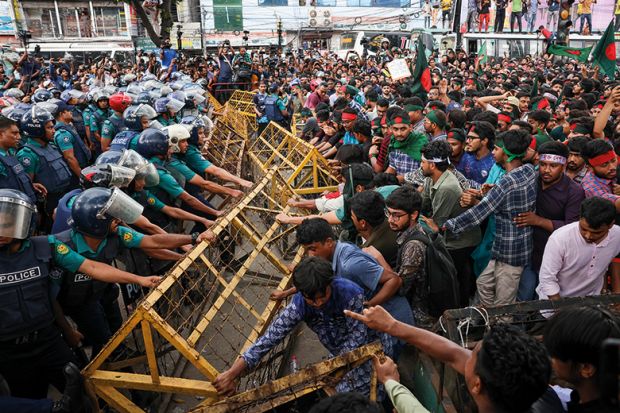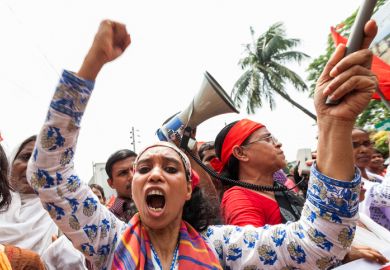It is a remarkable achievement for student protests to bring down a repressive government, as they have in Bangladesh. Yet whether the country in general and universities in particular change for the better as a result remains to be seen.
A series of largely peaceful student protests on university campuses against a system of quotas for government jobs rapidly escalated into a national crisis, leading prime minister Sheikh Hasina to resign and flee the country on Monday. But that was not before more than 300 people, mostly students, were killed, with protesters being subject to the excessive use of lethal force, enforced disappearance and torture by law enforcement agencies.
And while the brutal suppression was unprecedented in its scale and ferocity, it occurred in the context of long-running processes overseen by successive Bangladeshi governments to stifle academic freedom, politicise universities and suppress freedom of speech, thought and association among students.
Political control of the halls of residence at Bangladesh’s 55 public universities underpins a sophisticated system of political patronage that benefits the parties’ affiliate student wings. The Bangladesh Chatra League (BCL), the student wing of the currently governing party, the Awami League, played a key role in the escalation of the current conflict, as well as in stifling freedom of speech on campuses more generally.
During the Awami League’s 15-year tenure, this system granted the BCL an exclusive licence to carry out violence with impunity on campuses, including harassment, extortion, racketeering and sexual violence. This has had a devastating effect on the experience and freedoms of ordinary students, especially financially vulnerable rural-to-urban migrants who rely on heavily subsidised university halls of residence for housing. They are exposed to exploitation, intimidation and violence by the BCL, which coerces them to participate in political rallies and agitation.
Members might join the BCL for protection, power or financial gain, and typically include current students and recent graduates. The organisation uses its impunity to monitor and suppress anti-government views. For instance, in 2015, Anas Ansar, a master’s student at the University of Dhaka, was brutally beaten and turned over to the police as a terrorist by the BCL after voicing criticism of the cross-border shooting of a teenage Bangladeshi girl by the Indian Border Security Force in a university cafeteria. The Indian government is widely viewed as an important ally of Hasina’s government, and it is to India that she fled on Monday.
In an even more tragic example from 2019, a student at the Bangladesh University of Engineering and Technology, Abrar Fahad, was found dead in a torture cell run by the BCL in the university’s halls of residence after criticising a water-sharing agreement with India on Facebook. Although the police attended the scene, they reportedly left three hours later at the behest of the BCL – an hour before Fahad was declared dead – without entering the torture cell.
A cursory Google search reveals many more dreadful examples, and the anti-quota protests began against this backdrop. On 15 July, the BCL began a nationwide programme to brutalise what were until then largely peaceful protests. Video footage shows the BCL, using sharp weapons and firearms, being aided in their attacks by the police. These attacks coincided with inflammatory comments by Sheikh Hasina labelling protesters razakars, a hateful and dehumanising term used to describe those who collaborated with Pakistan against the formation of Bangladesh, for not supporting the jobs quotas, which reserve 30 per cent of all government jobs for supposed descendants of liberation war veterans.
As part of its attempts to disperse the protests, the government shut down all universities, including halls of residence, on 17 July, rendering tens of thousands of students homeless. Even so, the protests proliferated, leading to a curfew and the mobilisation of the army, with orders to shoot on sight.
After the 11-day internet and communication blackout was lifted on 23 July, numerous videos emerged of lethal force being used by the state on unarmed protesters including assault rifles, grenade launchers and gunfire from police helicopters. It also came to light that several leaders of the student protests were abducted by law enforcement agencies and tortured for days before being left unconscious by the wayside at disparate locations across the country. While recovering from these ordeals, several were again forcibly taken by police, in some instances from their hospital beds, and held for a further three days “for their own protection”.
Outrage at the killing of student protesters led to overwhelming public support. The violence peaked on Sunday, when more than 90 people were killed. Despite this, the very next day hundreds of thousands risked their lives to march on the capital, Dhaka, in contravention of a newly announced curfew, leading to the prime minister’s flight.
In this extraordinary chapter of history, an authoritarian government has been overthrown by a series of spontaneous student protests that lacked central coordination or alignment with any established political party. Although the nation rightly celebrates them as its liberators, however, these students should never have had to pay such a high price for their freedoms.
C. Rashaad Shabab is reader in economics and director of student experience at the University of Sussex Business School. He is co-author of the 2024 edition of Statistics for Economics, Accounting and Business Studies, published by Pearson.
Register to continue
Why register?
- Registration is free and only takes a moment
- Once registered, you can read 3 articles a month
- Sign up for our newsletter
Subscribe
Or subscribe for unlimited access to:
- Unlimited access to news, views, insights & reviews
- Digital editions
- Digital access to THE’s university and college rankings analysis
Already registered or a current subscriber?








